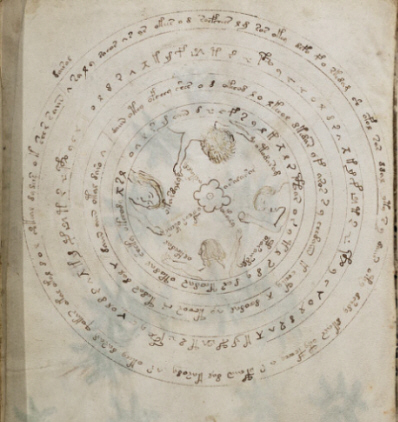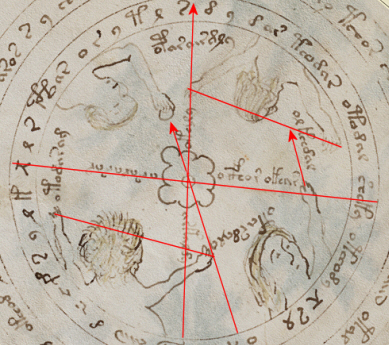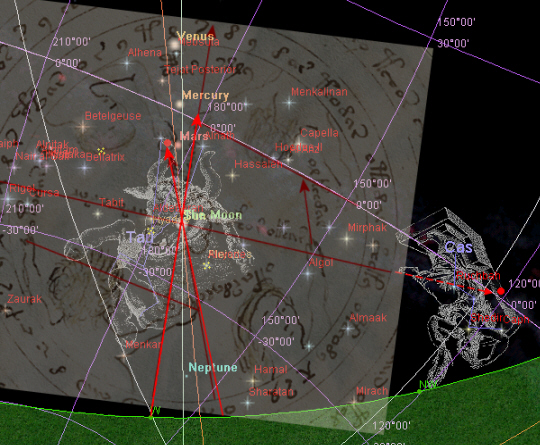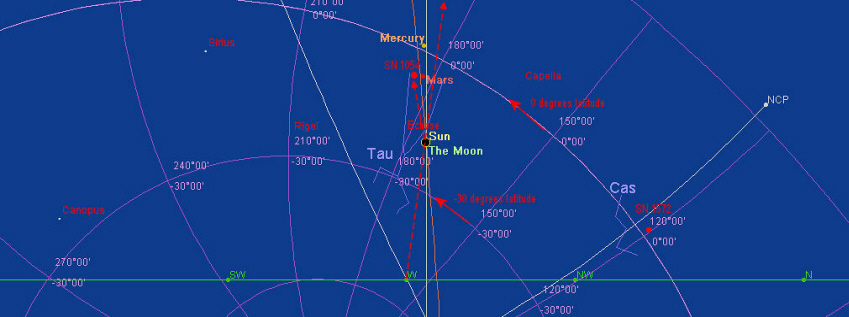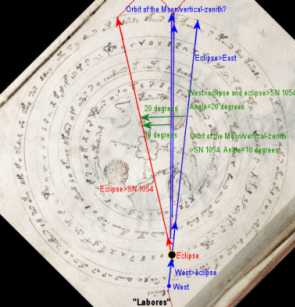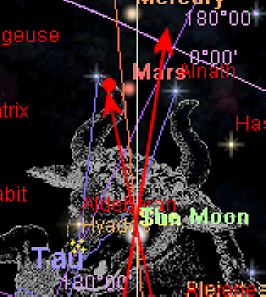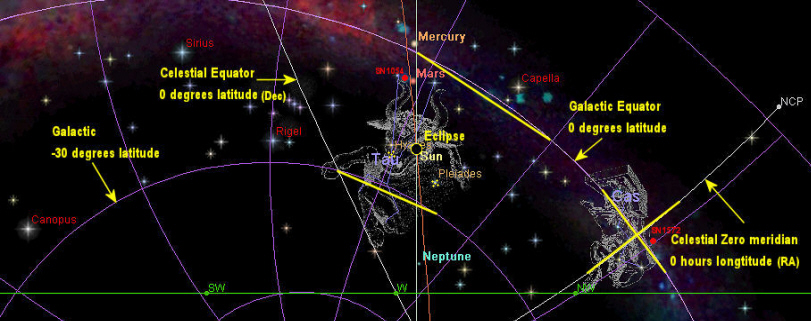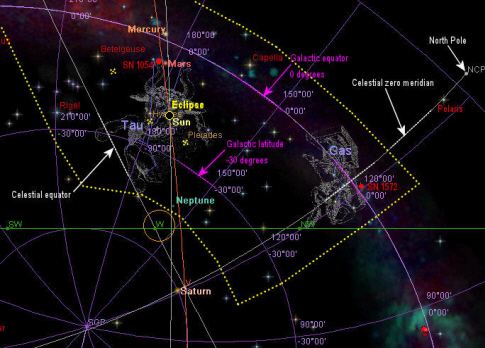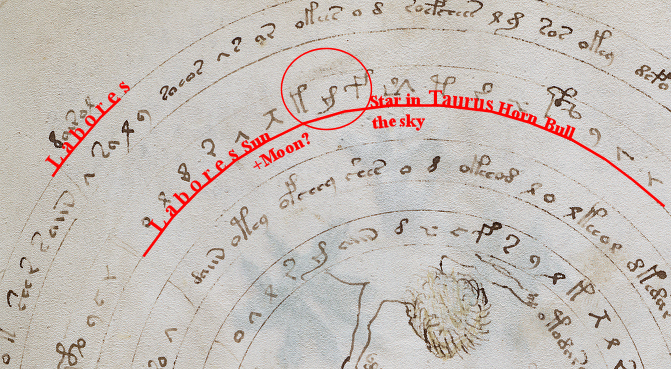|
|
|
f57v, cropped. Voynich Manuscript. Credit: Beinecke Rare Book and Manuscript Library, Yale University. |
I suggest f57v like f67v shows the total eclipse as seen in Central China on 10th May 1054 AD. In Kaifeng ,the capital of the Song Dynasty, as through most of China the eclipse would have been seen (and recorded) as a large partial eclipse (Recorded as being 9/10 eclipsed in Kaifeng in the Wenxian tongkao (Xiangwei: Omina and portents). But, for the sake of clarity I compare star maps from central China where the eclipse was total, furthermore information regarding the total nature of the eclipse in Central China could have been relayed back to the capital from the provinces. No doubt a total eclipse would be a more critical omen for the emperor, but even a large partial eclipse may have been easily hidden from him as he may not have personally observed from the confines of the palace.
There is general agreement that the first date SN 1054 was seen was July 4th as recorded in Chinese records but there are other records that suggest it may have been recorded earlier in some areas. Between and it would have been too near the sun to be visible but for a few fleeting minutes during the total eclipse it may have been visible for the first time, whether as an initial brightening during a period of instability before the star went supernova, or the actual supernova. The image at first appears quite simple but actually contains a lot of information and although it appears to be marked with all four directions as on a circular star map the information is consistent with an eclipse centred star map. The angle between the eclipse and SN 1054 as measured from the west is about 20 and I suggest the man top left appears to be holding the new star. When the figures and words radiating from the centre are overlaid on an actual eclipse centred star map the identities of the markers become apparent. The man top left is indeed holding the new star, the man bottom right points up to Capella, the man top right holds the milky way and the man bottom left hold one of the galactic latitudes (-30 ). The vertical marker matches the eclipse measured from the west, the horizontal marker through the eclipse and the top right man holding the milky way both point to SN 1572. The remaining labels in the central area may just be labels or markers leading to specific undetermined celestial objects, but along with the figures they also enclose the constellation of Taurus, the eclipse and SN 1504.
|
|
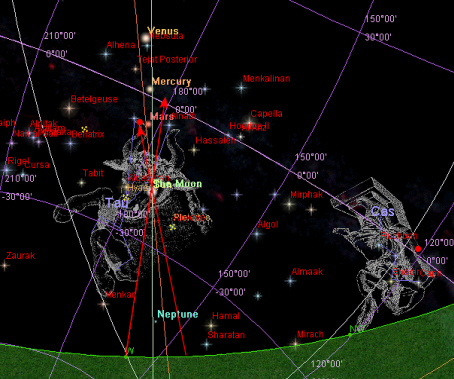 |
|
F57v, cropped. Voynich Manuscript. Credit: Beinecke Rare Book and Manuscript Library, Yale University. Overlay by P. Han, showing image in relation to the total eclipse of 10th May 1054 AD, as seen from Central China. |
Credit: Redshift6. 10/5/1054 AD, Central China. Overlay by P. Han, showing SN 1054 and the eclipse in detail. |
|
|
| F57v, Voynich Manuscript. Credit: Beinecke Rare Book and Manuscript Library, Yale University. Overlay by P. Han, showing image in relation to the total eclipse of 10th May 1054 AD, as seen from Central China. Credit: Redshift6. |
Below is a detailed European style horizon based star map of the sky during the eclipse as seen from central China.
|
|
| Credit: Redshift6. Horizon based star map, 10/5/1054 AD, Central China. Overlay by P. Han, showing SN 1054, SN 1572 and details of the eclipse. |
The markers on the page echo the information in the image but in a close up view, primarily confirming the angle of SN 1054 in relation to the eclipse and the west and the vertical/Moon orbit. Beneath the eclipse and west markers is a word I translate as “Labores”. Two of the lesser lines that follow the orbit of the Moon or vertical-zenith may represent one line but it is hard to tell. The ecliptic does not appear to be represented on f57v at all.
|
|
|
|
f57v,cropped. Voynich Manuscript. Credit: Beinecke Rare Book and Manuscript Library, Yale University. Overlay by P. Han, showing markers on page in relation to the total eclipse of 10th May 1054 Ad as seen from central China. |
Credit: Redshift6. 10/5/1054 AD, Central China. Overlay by P. Han, showing SN 1054 and the eclipse in detail. |
In conclusion I suggest f57v shows the eclipse of 10th May 1054 AD from Central China as does f67r and also that f67r records the event from the perspective of Celestial co-ordinates and f57v from the perspective of galactic co-ordinates, i.e., its relationship to the Milky Way. The image below shows the importance of the Celestial and Galactic co-ordinate systems in relation to SN 1054 and SN 1572 and the relationship of the two supernovas to each other.
|
|
|
Credit: Redshift6. Horizon based star map, 10/5/1054 AD, Central China. Overlay by P. Han, showing SN 1054, SN 1572, the eclipse and their position in relation to the Celestial and Galactic co-ordinate systems. |
The area contained within the galactic latitudes 0 > -30 degrees (as I suggested are shown by the figures with outstretched arms in the image on f57v), the Celestial Meridian and the upper part of the Celestial Equator are shown in the images below, from the point of view of the European style horizon based star maps and the Chinese style North Pole centred circular star maps. This specific area contains both SN 1054, SN 1572 and the total eclipse. This enclosed area I suggest forms the basis for the main subject matter of the whole of the non-botanical sections of the Voynich Manuscript.
|
|
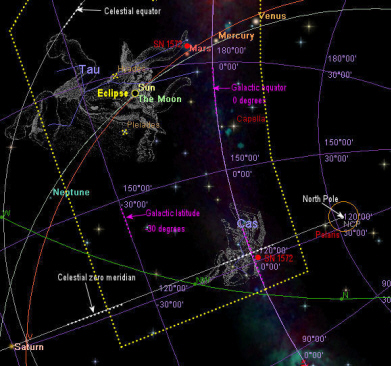 |
|
Credit: Redshift6. Horizon based star map, 10/5/1054 AD, Central China. Overlay by P. Han, showing the area contained within the galactic latitudes 0>-30 degrees, the Celestial Meridian and the upper part of the Celestial Equator, on a European style horizon based star map. |
Credit: Redshift6. Horizon based star map, 10/5/1054 AD, Central China. Overlay by P. Han, showing the area contained within the galactic latitudes 0>-30 degrees, the Celestial Meridian and the upper part of the Celestial Equator, on a Chinese North Pole centred circular star map. |
An example of attempted translation in part below and how it led to the suggested subject matter. The glyphs in the first and third circle are somewhat unique and different from the general text of the manuscript and I suggest they are to some degree pictorial in composition. Now the letters in the circle may be translated most obviously as as "marriage of/united" or a related word but more intriguingly and the only example I could personally find containing c, d and g in a single word is "adaugescere" or some form of this verb. The implications for the latter choice which means "to grow bigger" is that the supernovae became bigger or more visible during the eclipse by default suggesting it was already visible before the 10th May (earlier missing folios could also then refer to its first appearance). In Song dynasty China it was not recorded until 4th July but there a a good number of other earlier references to a bright star in a number of different cultures that year which suggest it may well have appeared months before this date, as early as 11th April (Ibn Butan) or 19th April on the day of the death of Pope Leo (Tractatus de ecclesia S. Petri Aldenburgensi).
|
|
| f57v, cropped. Voynich Manuscript. Credit: Beinecke Rare Book and Manuscript Library, Yale University. Overlay by P. Han, showing suggested translation of various labels and glyphs. |
Research has been done on this matter by a number of people and there are some links below to a few papers.
Francesco Polcaro, Andrea Martocchia. "Supernovae astrophysics from Middle Age documents." Populations of High Energy Sources in Galaxies Proceedings of the 230th Symposium of the International Astronomical Union, Held in Dublin, Ireland 15-19 August 2005, Edited by E. J. A. Meurs; G. Fabbiano. Cambridge: Cambridge University Press, 2006., pp.264-268. PDF on link.
http://hal.archives-ouvertes.fr/hal-00013372/en/
George W. Collins II, William P. Claspy, and John C. Martin. "A Reinterpretation of Historical References to the Supernova of A.D. 1054." Publications of the Astronomical Society of the Pacific, 111:871–880, July 1999. Free full text article on link.
http://www.journals.uchicago.edu/doi/abs/10.1086/316401
Copyright © 2010 P. Han
